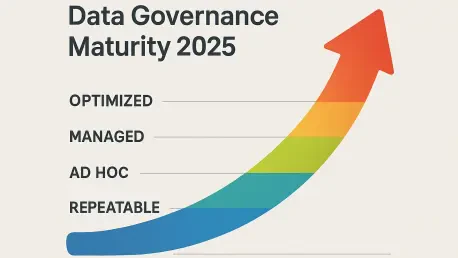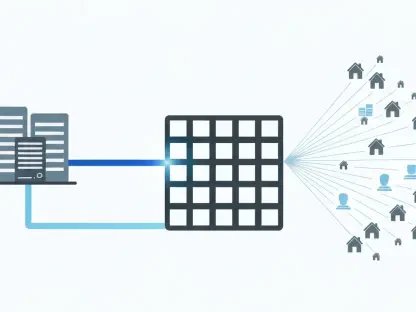What happens when an organization’s data becomes both its greatest asset and its most significant liability? In 2025, with data breaches costing enterprises an average of $4.45 million per incident according to recent studies, the stakes for managing data effectively have never been higher, and across industries, from healthcare to finance, companies are grappling with sprawling data ecosystems, stringent regulations, and the relentless pace of technological change. The solution lies in a structured approach to data governance maturity—a roadmap that transforms chaos into control. This exploration dives into the critical models shaping data governance today, offering insights and strategies for organizations determined to harness their data potential.
The Urgent Need for Data Governance Maturity
In a digital landscape where data is the lifeblood of decision-making, the maturity of governance practices determines whether an organization thrives or falters. Poorly managed data can lead to compliance fines, eroded customer trust, and missed opportunities, while robust governance unlocks innovation and competitive advantage. A 2025 report from a leading industry analyst reveals that 80% of organizations with advanced data governance frameworks report higher operational efficiency. This stark contrast underscores why maturity is not just a technical concern but a strategic priority for business leaders navigating an increasingly complex environment.
The concept of maturity in data governance refers to the sophistication and effectiveness of processes that ensure data is accurate, secure, and accessible. It’s about moving beyond ad-hoc practices to a systematic framework that aligns with business goals. As regulatory bodies tighten their grip—think GDPR or CCPA—and as cyber threats evolve, organizations can no longer afford to treat data governance as an afterthought. The urgency to assess and advance maturity has become a boardroom discussion, reflecting a shift in how data is perceived as a core asset.
Escalating Risks in a Data-Driven Era
Beyond strategic importance, the risks tied to inadequate data governance are escalating at an alarming rate. With data volumes projected to grow by 30% annually from 2025 to 2027, organizations face unprecedented challenges in maintaining control over their information assets. High-profile breaches and non-compliance penalties serve as stark reminders of what’s at stake. For instance, a major retailer recently faced a $10 million fine for failing to secure customer data, highlighting the financial and reputational damage that can result from governance gaps.
Emerging technologies like artificial intelligence and machine learning further complicate the landscape, amplifying the need for structured oversight. These tools, while powerful, rely on high-quality, well-governed data to deliver value. Without maturity in governance practices, the risk of biased outputs or flawed decision-making skyrockets. This reality pushes organizations to prioritize frameworks that not only mitigate risks but also build trust with stakeholders, ensuring data serves as a reliable foundation for innovation.
Key Maturity Models Shaping Data Governance Today
Navigating the path to data governance maturity requires a deep understanding of the frameworks available in 2025. Models such as DAMA DMBOK, Gartner’s Data Governance Maturity Model, IBM’s approach, CMMI Data Management Maturity Model, and the EDM Council’s framework stand out for their comprehensive structures. Each offers unique strengths: DAMA DMBOK provides a broad focus on data management and stewardship, while Gartner emphasizes compliance and data ownership, making it ideal for regulated industries like finance.
Specific applications bring these models to life. A healthcare provider, for instance, might adopt IBM’s model to standardize policies across disparate systems, ensuring patient data integrity under HIPAA requirements. Meanwhile, a financial institution could leverage CMMI to integrate data processes with broader organizational goals, driving continuous improvement. These examples illustrate how selecting the right model depends on specific needs, whether it’s enhancing data quality, meeting regulatory demands, or aligning with strategic objectives.
Understanding the nuances of each framework is crucial for tailoring governance efforts. The EDM Council’s model, with its six levels, excels in lifecycle management, appealing to organizations focused on analytics. In contrast, Gartner’s five-stage approach helps transition from reactive to proactive governance. By mapping these models to business priorities, organizations can chart a clear path toward maturity, avoiding the pitfalls of a one-size-fits-all solution.
Expert Perspectives and Real-World Success Stories
Insights from industry leaders and tangible outcomes provide a grounded perspective on the impact of maturity models. A prominent data management consultant recently noted, “Maturity isn’t just about checking boxes; it’s about embedding a culture of accountability and trust in data practices.” This sentiment aligns with 2025 research indicating that organizations at higher maturity levels are 60% more likely to achieve regulatory compliance without significant disruptions.
Real-world applications add depth to these insights. Consider a utility company that adopted the CMMI model to overhaul its legacy systems. By focusing on process integration, the company reduced operational downtime by 25% within a year, demonstrating the transformative potential of structured governance. Similarly, at a recent industry conference, a speaker highlighted how cultural resistance was overcome in a tech firm by aligning maturity assessments with employee training, fostering buy-in across departments. These stories emphasize that success hinges on both strategy and execution.
A Step-by-Step Guide to Elevating Governance Maturity
For organizations ready to take action, a practical roadmap to assess and advance data governance maturity is essential. The process begins with forming a dedicated assessment team, ideally comprising senior data professionals and external experts for objectivity. Defining clear objectives—whether improving data quality or ensuring compliance—sets the foundation for meaningful evaluation. Selecting a suitable model, such as DAMA DMBOK for comprehensive coverage or IBM for policy focus, ensures alignment with specific goals.
Data collection through surveys, interviews, and documentation reviews provides a holistic view of current practices. Analyzing this information against the chosen model’s criteria reveals gaps and opportunities, guiding the creation of a phased improvement plan. Tools like a data governance maturity scorecard can distill complex findings into actionable insights, with scores ranging from ad-hoc (1) to optimized (5) across domains like stewardship and security. Prioritizing high-impact areas, such as addressing low scores in compliance for a healthcare entity, ensures resources are allocated effectively.
Industry-specific challenges must also be considered when crafting this roadmap. A banking institution might focus on data lineage for auditability under Basel III, while a utility company targets standardization for operational reliability. Implementing changes requires ongoing monitoring and periodic reassessment—often every six months initially—to sustain progress. This structured approach transforms maturity from an abstract concept into a tangible driver of business value, equipping organizations to navigate their unique data landscapes with confidence.
Reflecting on the Journey and Charting the Next Steps
Looking back, the journey through data governance maturity in 2025 revealed how far organizations have come in recognizing data as a strategic asset. The exploration of key models, expert insights, and practical steps painted a vivid picture of transformation—from chaotic, reactive practices to disciplined, optimized frameworks. Each story of success, whether a utility streamlining operations or a healthcare provider securing patient trust, underscored the profound impact of structured governance.
As the digital landscape continues to evolve, the focus shifts to sustaining momentum. Organizations are encouraged to revisit their maturity assessments regularly, adapting to new regulatory shifts and technological advancements. Investing in training for data stewards and leaders emerges as a critical next step, ensuring skills keep pace with ambition. Above all, fostering a culture that values data accountability becomes the cornerstone for future resilience, promising a horizon where data not only supports but drives enduring success.









